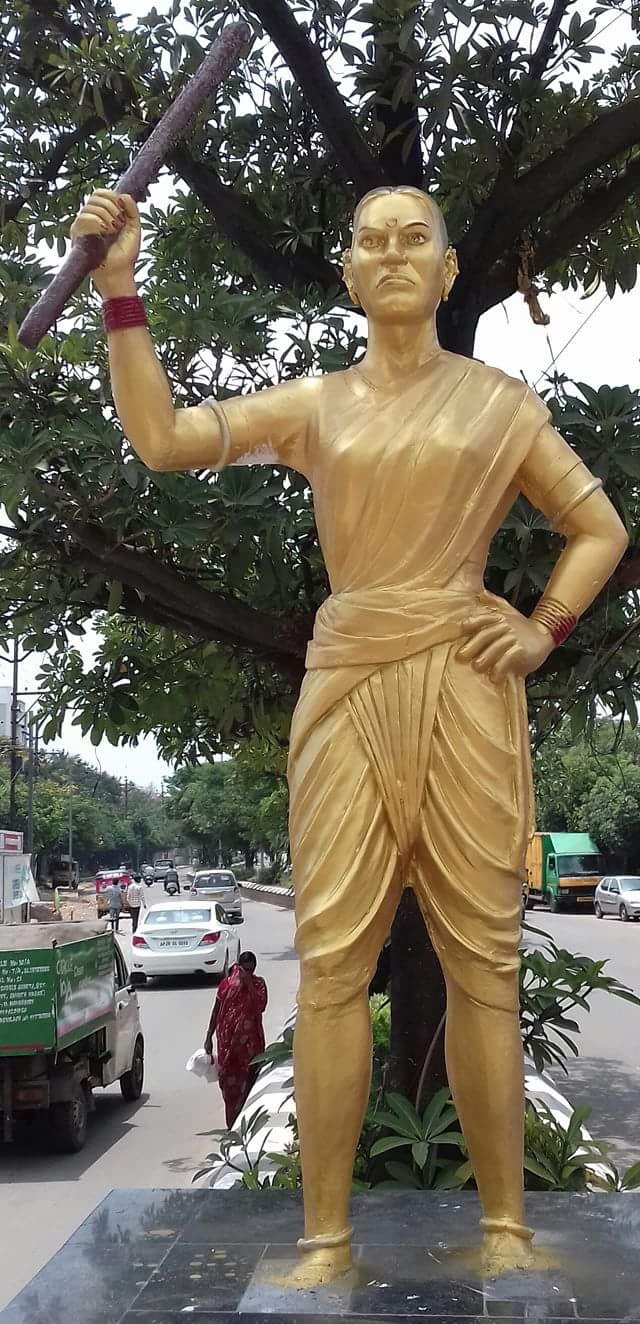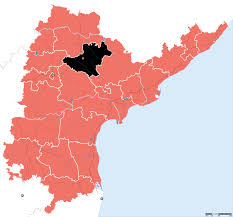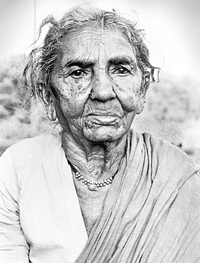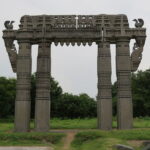In the quest to preserve and propagate essential Andhra culture, or Telugu Thanam if you will, there is often a tendency to overlook the contributions of the masses. But it is also important to document the well-deserved praise and accomplishments of so-called lower classes.
One such woman hails from such a backward caste community, but reached the very forefront of Telangana and greater Telugu history. This brave lady rose up and inspired the masses against the tyranny of the coloniser Nizam razakars, as well as their shameless Telugu collaborators. Rather than a typical war of caste pride (which characterises our current time) it was a noble uprising for Telugu Thanam and the safeguarding of the culture and self-respect of high and low.
All true Telugus salute the accomplishments of a brave woman known to us today as Chaakali Ailamma.
Background
Despite the colloquial name she is known by today, Ailamma’s actual surname was Chityala. Her husband was Narasayya Chityala, and the family had 5 children. Ailamma was born in 1919 at Krishnapuram village, in Rayaparthi mandal of Warangal District.
What is now Telangana state was then under the cruel oppression of the videshi origin nizam and his razakar enforcers. She came from the rajaka or washerperson “chaakali” caste, and would grow up to give this half of the Trilinga desa a thorough washing from the dirt of turkic rule.
She played an inspirational role in the Telangana Peasant Rebellion, known to Telugus as Telangana Sayudha Poraatam. In the present time, due to small-mindedness and ignorance from all regions of unified Andhra Pradesh state, people have forgotten the crucial role Hyderabad Princely State’s Andhra Maha Sabha played in the Freedom Struggle. “Andhra Mahasabha leaders sent communication to the villages that civilians should form volunteer forces and wield lathis to defend themselves. Because of the baton-wielding members, villagers fondly called the organization Gutupala Sangham. Andhra Mahasabha leaders reasoned that their action was a defensive act against Nizam’s Zamindari Goondas“. [1, 167]
It was in this context that Chityala Ailamma would play a pivotal role in sparking this Popular Revolt. “A washerwoman, Ailamma, was a staunch supporter of the sangham [Gutupala Sangham of Andhra Mahasabha]. In order to teach her a lesson, Ramachandra Reddy sent 100 goondas and another 1000 of his servants to retrieve her harvest. The Andhra Mahasabha leaders, becoming aware of this, came to Ailamma’s rescue. About 28 of sangham volunteers put their lives on the line, attacked the zamindar’s goons with sticks, and succeeded in driving them away.” [2, 168]
The injustice against her was specific, but for those who recall that terrible era for Telugus of Telangana, self-respect was an almost suppressed word. Telugu was disrespected, education only in the foreign persian-based urdu, begari (bonded labour) the legal rule, and rule was by a central asian turk chamcha of the defeated mughals, with his razakars routinely engaged in rapine and plunder.
“Its paramilitary force, the razakars, were sent in hordes to suppress the peasant insurrection. They “raided and plundered the troubled villages, arrested or killed suspected and potential agitators, terrorized the innocent, and also abducted women as part of the campaign of punitive measures against the turbulent villages all over Hyderabad, but particularly in Telengana”” [6]
This cowardly asaf jah dynasty had seven generations of misrule not due to bravery but due to their shameless collaboration with the British. In fact, the nizam was the first ‘prince of India’ to sign the Treaty of Subsidiary Alliance, becoming a puppet state of the British East India Company. Having been given by the mughals most of medieval Andhra, this dynasty of weaklings nevertheless signed up to be colonised. After all, being colonisers themselves, what pride of land could they have to resist the new colonisers?
“The people of Hyderabad suffered from double disadvantage. Apart from the overall domination of the British, they had to bear the oppressive rule of the Nizam, who being of [Turkic] Persian origin, had no sympathy for the nationalist and cultural aspirations of his Hindu subjects who formed 88 percent of the population.” [2, 271]
That is the importance of self-respect, and Chityala Ailamma had it in spades. She first joined the Andhra Maha Sabha before signing up with the Communist party. It should be clarified that the recent use of ‘Andhra’ to refer only to Coastal Andhra is incorrect. ‘Andhra’ historically referred to Andhra desa, which included Kosta, Telangana, and Rayalaseema regions. Hence Andhra was the original Sanskrit name of Telugu speaking peoples. This is further evidenced by the founding of Andhra Maha Sabha in Hyderabad Princely State.
“The Government did not allow even the private institutions to impart education in the language of the people. The people of the State did not even have the elementary rights of citizenship. The condition of the agricultural tenants was deplorable. The big landlords known as Maktedars and Pattedars subjected their tenants to serfdom and slavery known as baghela and vetti chakiri (Begari).” [2, 267]
In response to this, the great Telangana defenders of Telugu Thanam banded together to preserve Telugu Thalli.
“Madapati Hanumantha Rao who was chosen as the secretary of the Sangham, guided its destinies and did yeomen service for the cultural upliftment of the Andhras of Telengana. The Andhra Jana Sangham aimed at the social, economic and cultural revival of the people of Telengana“. [2, 268]
But when faced with violent, sadistic terror, even the peaceable Telangana Bhoomiputras realised force had to be met with force.
“The revolt in Telangana was sparked by the murder of Doddi Komarayya, a worker of the nascent nationalist movement called the Andhra Maha Sabha (AMS), in July 1946. The struggle took place at a time when the Nizam was trying to resist the efforts of the Indian government to merge his state with the Indian union.”[5]
This pic, the brave Telangana woman's fighting against the Hyderabad Nizams…!
The historic fight of Telanganites ”Telangana Sayudha Poratam” against the Nizam Razakar rule where women’s of Telangana were forced to pray Bathukamma nudely and they were treated as slaves..
1/2 pic.twitter.com/dXimBkv3dU
— KY (@kyyadhu) September 9, 2019
“The Razakars— the newly formed fundamentalist militia of the Majlis-e-Ittehadul Muslimeen— joined the Nizam’s army and the police in suppressing the peasantry.
Despite the reign of terror, the communists succeeded in establishing a parallel government in Nalgonda, Warangal and Khammam districts. The hated landlords, who were the pillars of the Nizam’s autocracy in rural areas, were driven out from their fortress-like houses and their lands seized by the peasantry.” [5]
Slowly but surely, the Peasant Rebellion gained steam. The Andhra Jana Sangha had changed its name to Andhra Maha Sabha, and the communists operated under this banner. Arms began flowing from outside the state, and the guerrilla tactics of the peasants began paying off. Chaakali Ailamma herself was involved in this Revolution against razakar tyranny. Many strategic and tactical activities against them were planned at her house. Inhumane Crimes of urdu razakars are remembered with revulsion to this day by the descendants of those victims.
My maternal great grand parents of Warangal had to face the ire of Nizam during Razakar movement in 1940's. 1/n #Telangana
— Srikanth (me & my parivar) (@JayaHoIndia) August 2, 2013
Telangana and the Marathi and Kannada regions of Hyderabad were liberated on September 17, 1948. Within a mere four days of seeking to wage war against the newly established Republic of India, the nizam’s pathetic army (only useful against the weak and vulnerable) wilted and surrendered. [5]
The matriarch of the Chityala family would live to see the independence of India, and especially her native Telangana—which long groaned under the tyranny of turkic invaders. The asaf jah dynasty was overthrown. She attained svarga in 1985 after a long and momentous life, restoring Telugu self-respect for all castes.
Achievements
The life of Chityala Ailamma is more than a mere resume of accomplishments. Sometimes, it is a single act of courage that can define a lifetime of achievements.
Perhaps what was most notable about her life was that she was not a great royal like Queen Rudrama Devi, but a common woman with which the common person could identify. Her own family and especially daughter had to face the demonic tyranny of the nizam’s deshmukhs. In spite of this, she rose up to say, “no more”. She refused the unjust fine of her entire harvest, and safeguarded her 4 acres through the Andhra Maha Sabha’s Gutupala sangham, that she had joined. Just to understand the scale of what she would eventually face, here is an adumbration from the times.
“According to official records, 35,000 people were arrested in the Hyderabad State and tortured. About a lakh bogus cases were booked against the participants of the movement. However, the Nizam continued his brutal oppression and was not ready to recognise India’s independence in 1947. As part of this historic struggle to liberate the Hyderabad State, 4,500 people sacrificed their lives.” [7]
Rather than the marxism of che, it was the idea of the every day self-respect that is the birthright of every woman that this washerwoman stood up for.
“though she was born as a middle class washerwoman, Ilamma actively participated in the movement against Nizam regime and her house was the centre of activities against the feudal lords, who shook hands with Nizam.”
Though she did not fall in battle like Komarayya, she would inspire many like him to stand up and look their tyrannical oppressors square in the eye.
Legacy

Communists, Revolutionaries, and Naxalites (deservedly) have a bad name today. However, despite their modern exploitation of the masses, they did play a role in the Sayudha Poraatam. The natural and justified rage the peasantry had against the feudal patel-patwari landlords made Hyderabad state—and indeed all of Andhra desa—fertile ground for such revolutionary activities. While marxism is itself a misguided ideology, it was a useful banner for the oppressed peasantry of various castes and creeds, to gather around and fight against the foreign coloniser turkic Nizam and his native telugu flunkies.
Today, despite playing to the crowd, the cronies of the nizam are once again re-surfacing. Much like that era of oppression, they actively mock Telugu, seek to impose urdu on people, commit crimes against women, and seek to exploit the masses. Slowly but surely, the signs are again creeping back. The hinterlands of Telangana are once again reeling under dearth and penury, while feudal landloards enjoy in Hyderabad. Perhaps the time is fast approaching for the anthem of a bygone era to again play in the bazaars.
“Chakali Ilamma, belonging to Rajaka caste, revolted against zamindar Ramachandra Reddy, who tried to usurp her four acres of land. Her revolt inspired many to join the movement. Today, we see hundreds of statues of Ilamma installed in Telangana. The song, Bandenaka Bandi Katti, by Suddala Hanumanthu, narrates this struggle even today.” [7]
Girding up her sari, this great Telugu girl of yesteryear recognised that freedom had to be earned rather than received. The masses of Telangana were in great tumult and they waged war against the plundering princely state that denied them not only a decent living or decency, but even pride of culture and language. The unjust patel-patwari (karnam) system had been used to maximum effect by the turkic dynasty of Hyderabad.
Golkonda fort had been a grand achievement of the Kakatiya dynasty, as even Marco Polo praised the citadel while passing through united Telugu desa. Hyderabad was but an extension of this, and was used by colonisers to exploit the wealth that was the Telugu people’s by birthright. It is Telugu people who are the true Bhoomiputras of the land. And so a People’s War was waged against the unjust nizam state and its shameless collaborators (many of whom have resurfaced after bifurcation).
“the Nizam’s refusal to join the Indian union resulted in the communist-led movement in the Hyderabad state gaining the character of a national liberation struggle. The aim was to free the people from the rule of the Nizam and also put an end to the feudal order.” [5]
1948 :: Sardar Patel Worked For Unification of India , Nizam of Hyderabad Surrenders to Sardar Patel pic.twitter.com/NUGvtDO47f
— indianhistorypics (@IndiaHistorypic) February 27, 2020
“Simultaneously, the Central government on September 13, 1948, initiated police action against Hyderabad not only to put an end to the Razakar terror but also the communists. Succumbing to pressure, the Nizam finally agreed to the accession. He surrendered on September 17, 1948, and the Razakars were disbanded.”[5]
The cowardly coloniser nizam surrendered to Sardar Patel, but the victory was ultimately achieved by the courageous men and women of Telangana, who teamed up with their brothers & sisters from Coastal Andhra to wage a war of liberation against foreign tyranny. Men and women like Chaakali Ailamma are singularly deserving of homage from high and low today, for their sacrifice in the name of Telugu self-respect and dignity for all Telugus. Her early enrollment in the Andhra Maha Sabha is proof of this. That period of history also demonstrates it was foreign colonists who were interested in referring to coastal Andhras as ‘settlers’.
“The Hyderabad Government suspected that the Sabha had sinister designs to disintegrate the State. It felt that the name ‘Andhra’ was full of dangerous possibilities. But the Telengana leaders stuck to the world ‘Andhra’ and re-fused to substitute it by Telugu or Telengana.” [2, 269]
It is said that “The Beginning of wisdom is to call things by their correct name“. The insidious nature of this terminological warfare has been noted elsewhere.
“the term Telangana represents the entire geography of the state of Andhra Pradesh, and not just the nine districts ruled by the Nizam. Similarly the term Andhra represents all Telugu-speaking people of our state. This is how all Telugus have identitied themselves up until 1953.” [1, 23]
Much is made today of Chityala Ailamma’s association with the Communist Party (conveniently ignoring her membership in the Andhra Mahasabha). However, as was the case for the suffering masses of the time, most knew not the nature of the ideology. Unbeknownst to them, the politburo constituted another parochial elite that would later seek to exploit them through naxalism and state governments elsewhere in India. For the time being, they saw only a common banner under which to fight the tyranny they faced in nizam Telangana.
Indeed, the active participation of the Arya Samaj in the Freedom Struggle of Telangana from tyrannical turkic nizam rule showed the dharmic nature of the freedom fighters. “During the rule of Osman Alli Khan the steps to Islamise Hyderabad were intensified. With the encouragement of the government the blatant communal organisation Majlis-e-Ittehadul Muslimeen was founded.” [2, 273] Knowingly or not, Telugu figures fought to uphold the saamaanya dharma, the common dharma of right vs wrong, native vs foreign, and justice vs injustice.
The recent violence in Bhainsa is a mere taste of the terrible communal oppression Telugus of Telangana faced under the nizam. Indeed, not only the razakars, but even the MIM exists today, albeit, with “All India” pretensions. It seems they still haven’t learned the lessons of law and order taught to them by NTR.
Dalit or Brahmin, merchant woman or washer woman, all groaned under the turk’s terrible tyranny of Begari (bonded labour). It wasn’t until one Chaakalaama called Chaakali Ailamma stood up and said “no more”, that the masses finally fought back.
She remains to this day an inspiration to all Telugus, Inland & Coastal, male or female.
References:
- Chakravarthy, Nalamotu. My Telugu Roots. Bolingbrook, IL. BFIS Inc.2009
- Rao, P. Ragunadha. History and Culture of Andhra Pradesh: From the Earliest Times to 1991. New Delhi: Sterling Publishers, 2012
- Durga Prasad, G.History of the Andhras up to 1565 A. D. Guntur: P.G. Publishers.1988
- New Indian Express. https://www.newindianexpress.com/states/telangana/2016/aug/08/Chakali-Ilammas-life-to-be-captured-in-a-30-minute-long-documentary-1506823.html
- “The Red Revolt”. India Today. https://www.indiatoday.in/magazine/cover-story/story/20071231-the-red-revolt-734843-2007-12-20
- “People’s Struggles in India”. Ritimo.https://www.ritimo.org/The-Telengana-Movement-Peasant-Protests-in-India-1946-51
- “Liberation of Hyderabad”. Telangana Today. https://telanganatoday.com/liberation-of-hyderabad-telangana-movement
- “Chakali Ilamma remembered”. The Hans India. https://www.thehansindia.com/posts/index/Telangana/2018-09-11/Chakali-Ilamma-remembered-on-her-death-anniversary/411188/amp










Inspiring article showing the power of great dharmik women!